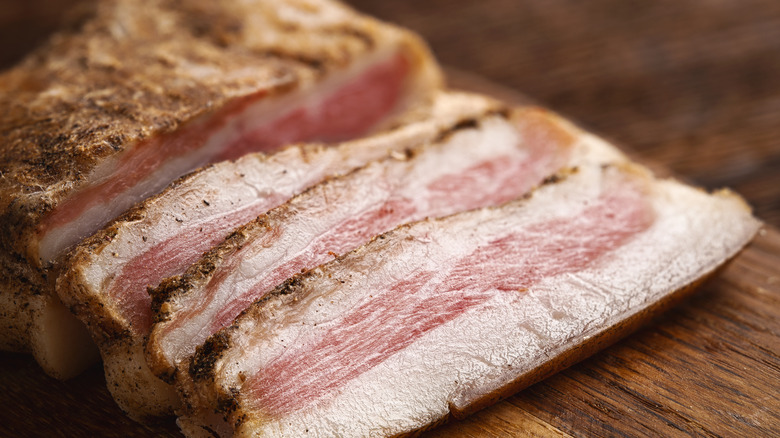How To Cook Pork Jowl, The Tender Bacon Alternative
Eating pork jowl may initially sound like the start to an overall unique dining experience here in the States, but the world clamors to slurp up bowls of carbonara, amatriciana, and alla gricia, three of Rome's classic pasta dishes. Each of these beloved dishes lists pork jowl — known better by its Italian name, guanciale — among its ingredients. We know: As is so often the case, it sounds nicer in Italian. But a rose by any other name would taste as delicious, and few things illustrate this as well as the often overlooked pork jowl.
Sometimes more sweetly referred to as the cheek, the jowl is a cut of pork taken from a pig's chin and jaw area. Similar to pork belly, this cut has a high percentage of fat and is super tender and juicy with a somewhat sweet flavor that complements and contrasts cuisines around the world. Pork jowl is a welcome addition to any dish you can imagine bacon in, but perhaps requires a little more richness and a bit more chew. You can fry, grill, smoke, braise, or sear it with great results, allowing you to take this cut in countless directions. Italians choose cured jowl when making their rich, silky pasta sauces, and Korean barbecue diners love crisping it up on the grill, wrapping it in lettuce or perilla, and pairing it with fresh and fermented banchan.
Easy opportunities for exploration
If you're a home chef looking to expand your culinary toolbox with this cost-effective and adaptable ingredient, the aforementioned dishes may be a bit more work than you're interested in — especially first thing in the morning. Thankfully, you don't need to be a trained Italian or Korean chef to give this ingredient a go — start with something simple and close to your comfort zone. There are countless ways to do so, which means you're sure to find an option that suits your palate and experience.
Because pork jowl is a natural bacon substitute, try frying it up and swapping out the bacon for a buttery carbonara breakfast sandwich, or incorporating it into a classic American breakfast spread of hash and fried eggs. Starting with something simple like this allows you to use familiar cooking methods to gain a sense of this ingredient on its own.
What does it taste like and how is it similar to or different from other pork cuts you've tried? If you'd rather dive right in and see how pork jowl plays out in a more complex dish, try adding it to a soup that could use a little extra silky savoryness. Or you can use its natural sweetness and richness to balance the earthy, bitter taste in collard greens or other cruciferous veg.


